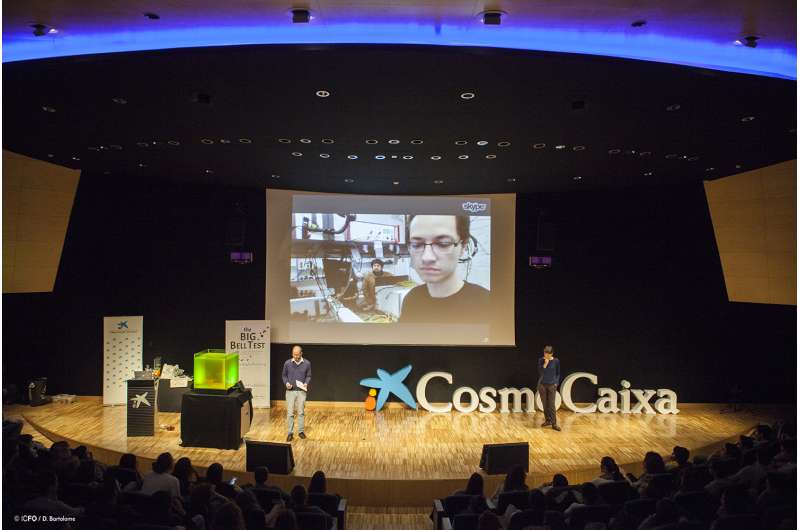Live connection with the laboratory in Concepción (Chile) during the grand event of the BIG Bell Test in CosmoCaixa, of the "la Caixa" Obra Social, on Nov. 30. Credit: ICFO/D. Bartolome
On November 30th, for the first time, participants around the world took part in a unique worldwide experiment with the aim of testing the laws of quantum physics.
Coordinated by ICFO-The Institute of Photonic Sciences, 12 laboratories from around the world collaborated for the BIG Bell Test: worldwide quantum experiments powered by human randomness with the aim of demonstrating experimentally that the nanoscale world is as strange as quantum physics predicts, consisting of particles in superstates that collapse only when observed; strange instantaneous interactions at a distance; predictions that were questioned by Einstein, who rejected them completely.
During the 48 hours during which it was November 30th somewhere on the planet, participants contributed to the initiative, generating sequences of zeros and ones through a video game to produce sequences of numbers that were as random as possible. Each of these bits was used to control the experimental conditions of the labs in real time. They moved mirrors, polarizing filters, waveplates—elements located on optical tables that affected the types of measurements made on the quantum systems in each lab.
All the participants provided scientists with millions of unpredictable, independent decisions that were used to measure their particles. This independence is a crucial feature for the conclusions of the Bell tests to be valid. Using the sequences provided by the participants, the scientists verified whether or not their particles were intertwined by the quantum entanglement that Einstein could not accept. In a nutshell, the Bell test states that experimentalists have to conduct their measurements with the help of human decisions and calculate the "Bell parameter" (also known as the parameter S). If the universe is predictable and without quantum entanglement, then S cannot be greater than two. That is, S should always be less than two. Otherwise, the inequality has been violated, indicating the presence of intrinsic quantum phenomena.
By 13:00 CET, the minimum number of participations needed to provide enough bits to power the experiments had already been surpassed, registering above 1000 bits per second in a stable manner over the course of several hours. By early afternoon CET, some of the labs had been able to obtain preliminary results, confirming violations of Bell's inequality, and thus confirming the predictions of quantum physics.
ICREA Professor at ICFO Morgan Mitchell reflects that "the project required contributions from many people in very different areas—the scientists pushed their experiments to new limits. The public very generously gave us their time in support of science, and educators found new ways to communicate between these two groups. I'm thrilled with all of the different things we have learned through the BIG Bell test."
Carlos Abellán, researcher at ICFO and instigator of the Project, says, "The participation we achieved today for the Big Bell Test is absolutely astonishing and unprecedented. I'm excited about all the results we're already receiving from the labs."
In Barcelona, in collaboration with the La Caixa Foundation, the BIG Bell Test team had the opportunity to share the project with an audience of more than 300 people gathered in the auditorium of CosmoCaixa, who watched the experiments running in labs in Shanghai (China), Concepción (Chile), Nice (France) and Castelldefels (Spain) via live feeds. This audience contributed to the experiment by participating in a final tournament of the video game, created with Kaitos Games, to determine the most random person in the audience. The event was streamed live around the world, and in China alone, generated an audience of more than 300,000 people. The BIG Bell Test has succeeded in demonstrating the unique value of human randomness and certain fundamental processes of nature.
More information: www.thebigbelltest.org/
Provided by ICFO





















